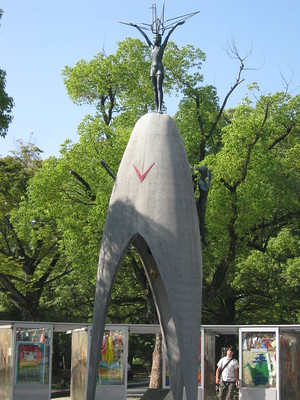The tradition of folding 1000 origami cranes, known as “senbazuru” in Japanese, holds a special significance and is deeply rooted in Japanese culture and history. Here’s the story behind it:
The legend of the 1000 origami cranes is associated with a young girl named Sadako Sasaki, who was exposed to radiation from the atomic bombing of Hiroshima in 1945 when she was just two years old. Tragically, at the age of twelve, Sadako was diagnosed with leukemia, a type of cancer linked to radiation exposure.

“Sadako Sasaki Children’s Peace Memorial” by ElCapitanBSC is licensed under CC BY-SA 2.0.
As Sadako underwent treatment and faced the harsh realities of her condition, she heard an old Japanese legend that promised anyone who folded 1000 origami cranes would be granted a wish, such as good health or long life. Inspired by this legend and determined to make a wish to be cured, Sadako began folding cranes using whatever paper she could find—wrapping paper, medicine wrappers, and even discarded paper from her classmates.
Tragically, Sadako’s condition worsened, and she could not complete the 1000 cranes. Nevertheless, her perseverance and determination captured the hearts of her friends and family, who completed the task on her behalf after her passing.
Since then, the act of folding 1000 origami cranes has become a symbol of hope, peace, and healing in Japanese culture. People often fold these cranes for various purposes, including:
- Prayer and Healing: Folding the cranes is believed to bring good luck, healing, and recovery. It has become a common practice for people to fold cranes and offer them to those who are ill or facing difficult times.
- Memorial and Peace: In memory of Sadako and the thousands who lost their lives due to the atomic bombing, people often fold cranes as a gesture of peace, hoping for a world free of nuclear weapons and conflict.
- Celebrations and Wishes: Senbazuru is sometimes folded to celebrate significant life events like weddings, births, and anniversaries, with the wish for a happy and prosperous future.
- Prayers for World Peace: Senbazuru is also made in large quantities and displayed in places like memorials and peace parks to send a message of peace and reconciliation to the world.
Overall, folding 1000 origami cranes has become a powerful symbol of hope, compassion, and the desire for a better world. It represents the power of small actions and the belief that collective efforts can bring about positive change.
How long would it take to fold 1000 cranes?
One origami enthusiast reported that folding one crane every 3 minutes in their spare time, they were able to complete the 1000 cranes in 10 weeks.
What is the story behind 1000 cranes?
In ancient times, cranes were thought to live for 1000 years.
How many cranes did Sadako Sasaki fold?
Some reports suggest that Sadako folded 644 cranes before becoming too ill. However, according to her brother, Masahiro, Sadako managed to fold 1400 cranes.
